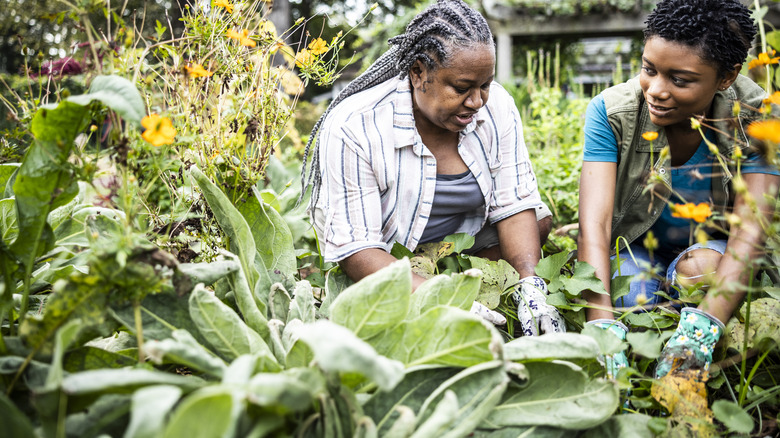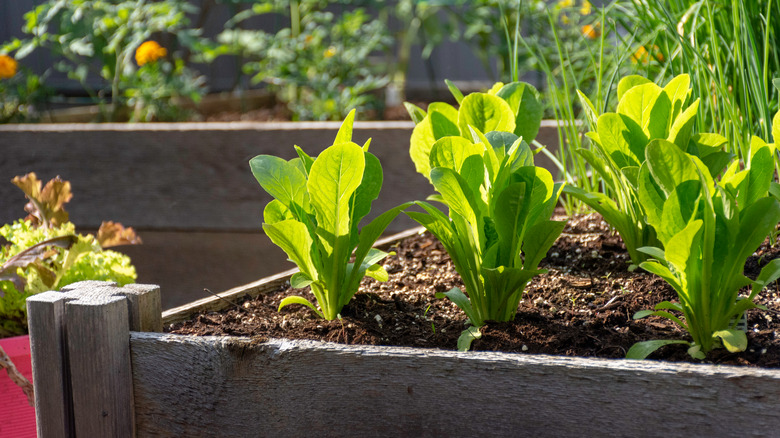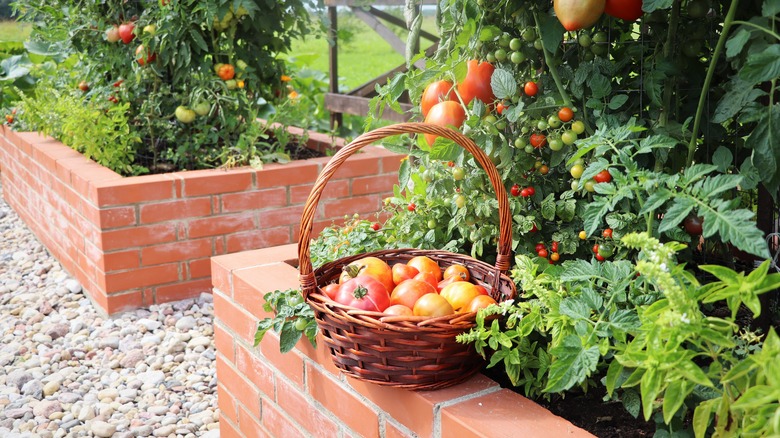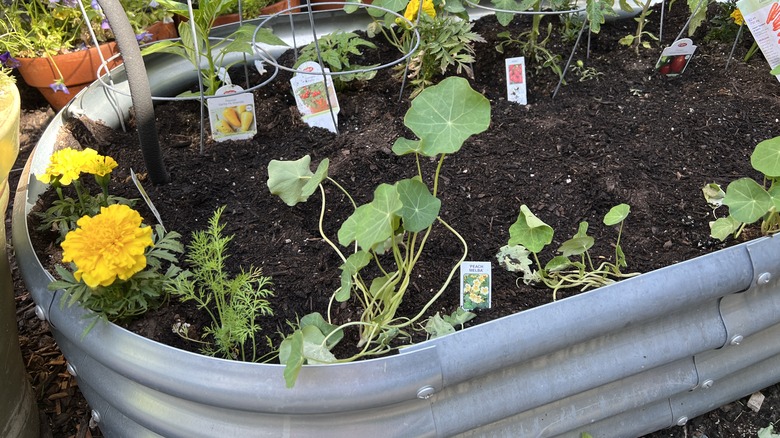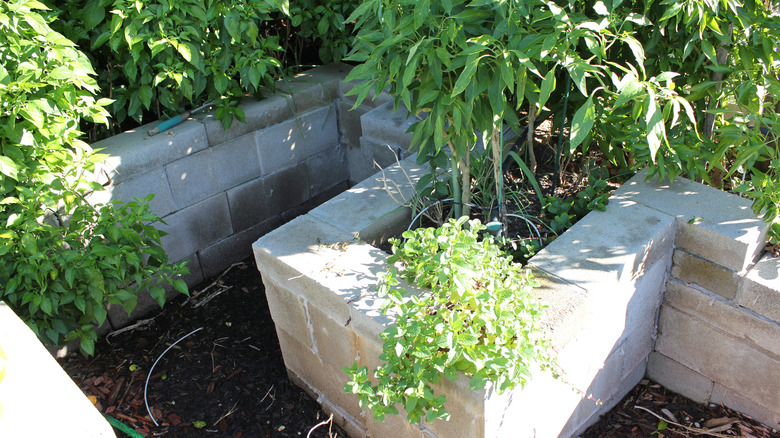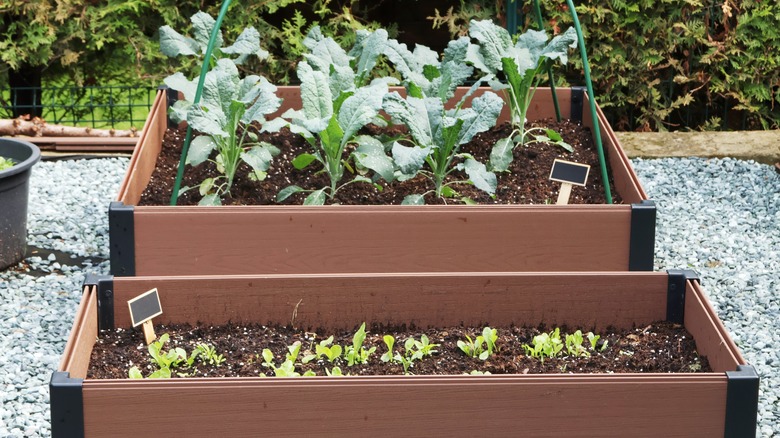5 Common Materials You Can Use For DIY Raised Garden Beds
We may receive a commission on purchases made from links.
A raised garden bed offers gardeners a bevy of benefits ranging from soil that drains better to fewer weeds encroaching when compared to ground-based gardens. They're also easier on the back and knees if you build them tall enough, and when constructed with wide walls, folks with mobility issues can sit on the side while tending a garden. The soil heats up quicker in the springtime in raised beds, too, so you can get a head start prepping for the growing season. With so many benefits, you might be itching to run out and grab some materials to get started constructing your raised bed. That means choosing from a variety of wood types, masonry selections, and even metal varieties that can quite capably serve the purpose.
When it comes to picking the right material, there are usually a few considerations including how you want the bed to look on your property and how large it needs to be so you can reach the center and still navigate around it. Keeping fruits and vegetables safe by selecting materials that won't contaminate your soil is vitally important as well. It may sound like the project is getting more complicated by the minute, but it doesn't have to be. Exploring the varied types available can help you narrow down the right material to put together a raised garden bed just right for achieving your homegrown goals.
Wood
Many gardeners like the natural look of wood for raised beds in their gardens. With some basic planning, you can visit a local home improvement center to buy posts and lumber to construct a wooden raised bed in the exact shape and size you need for your garden space. The type of wood you select does make a difference, though. If you want to follow organic guidelines, keep plants bearing food away from treated woods. With that in mind, you might suspect that using cedar wood for your raised garden beds is a good idea. If so, you'd be right. It naturally resists deterioration, and bugs will largely leave it alone. Another durable alternative is redwood, but it can be more costly than cedar. What about reusing wood that would otherwise be discarded? Anything treated with creosote is off limits so don't reuse old railroad ties or wooden utility poles for this purpose.
Feeling lost when it comes to knowing exactly what to buy for a project like this? To make it easier, you can purchase kits that have all the components necessary to construct the frame for a wooden raised garden bed. They vary in price depending on the size and, of course, the type of wood included in the kit, but they can be a good point of departure when you're just getting started. For instance, the easy-to-assemble Greenes Fence Premium Cedar Raised Garden Bed kit is available on Amazon for $49.99 per 16 x 48 x 5 inch bed.
Bricks
If you want a more permanent raised garden bed, consider brick. This is a great alternative that can last over time since the material won't readily deteriorate like wood. Brick also comes in a variety of shades, so if you live in a brick home, you can coordinate the look of your garden beds with your house. Stacking a couple of layers of bricks without mortaring them is doable, but if you want a bed that's taller and more stable, be sure to buy sand-based mortar made for home use to hold the walls together; many commercial cements have potentially dangerous substances that can leach into soil.
What about reusing bricks for this purpose? If you already have them on hand, or get a lead on some you can salvage for a reasonable price, you can indeed build an affordable raised garden bed by reusing old bricks. For shorter raised beds, you can also explore using leftover retaining wall blocks in a similar way.
Galvanized metal
If you decide to shop around for raised garden bed kits you can put together yourself, you'll likely run across quite a few made of galvanized metal. Some have a similar look to troughs for keeping livestock hydrated, and those can be used for creating raised garden beds, too. The material looks good in many settings and can be durable enough to last for years and years. In addition to flowering plants, these are often sold for growing fruits and vegetables, so they must be safe, right?
That's a worthwhile question since the galvanizing process involves treating metal with a coating made using zinc and smaller quantities of aluminum and cadmium. Planting in galvanized metal presents a contamination risk when the soil pH is lower than 5, and some fruits and vegetables will require more acidic soil than others. When using new galvanized raised metal beds and troughs, the risk is lower than with old ones that are worn and rusty, but you can certainly have your soil tested to make sure the pH level isn't on the risky side. If you have your heart set on the look of galvanized metal and want to be even safer, you can opt to add a plastic liner before you fill the raised bed with soil to help allay these types of concerns.
Masonry blocks
Many gardeners turn to cinder blocks, cement blocks, or concrete blocks to construct raised beds. The difference is that cinder blocks, which are made using fly ash (a fine form of coal ash), are lighter in weight than those made of cement and concrete. They are inexpensive compared to other materials, however, and they can all be long-lasting when used for landscaping projects. They're also versatile since they can be used in a single or double layer for a shorter bed or stacked and joined with mortar or construction adhesive. There's even a cinder block and glue DIY you can try using a product like Loctite PL Premium Max Construction Adhesive available on Amazon. Adding a concrete cap to a taller wall made with masonry blocks offers a spot for gardeners with mobility issues to sit while they're minding to their plants as well.
The caveat to keep in mind when using cinder blocks to construct a raised garden bed is that fly ash is a derivative of burned coal, so it can contain toxins like mercury, cadmium, and arsenic. There have not been a lot of studies about whether or not this is an issue when soil used for growing food touches material made with fly ash, but you may decide to coat the blocks with polymer paint or select an alternate type of material just to be safe.
Plastic
Yes, we know many households are trying to move away from plastics, but when it comes to prefab raised garden beds, plastic is a common alternative to consider. There are many garden bed kits available that have plastic components for the walls and some mimic the look of wood like the Giantex Raised Garden Bed for $79.99 on Amazon. Another alternative is to upcycle plastic totes and use them for raised garden beds. If you have some that no longer have lids, that might be a good opportunity to give them new life. Friends and neighbors can be a good resource for bins they no longer use, too. Want to raise them even further off the ground? Some gardeners repurpose old plastic lawn chairs that are worse for wear to elevate totes filled with plants.
Of course, you might be wondering, when growing food should you be concerned about using plastic? According to the United States Department of Agriculture, if a kit you buy is made of plastic deemed food-safe, you can use it for a raised garden bed. Which plastics are okay in that regard? Look for High-Density Polyethylene (HDPE) (#2), Low-Density Polyethylene (LDPE) (#4), and Polypropylene (PP) (#5) plastics as some alternatives to hold garden soil. As with other materials you consider for raised garden beds, you'll have to decide if plastic is a budget-minded choice that meets your wear expectations while supporting your goals for keeping your family and the environment safe.
